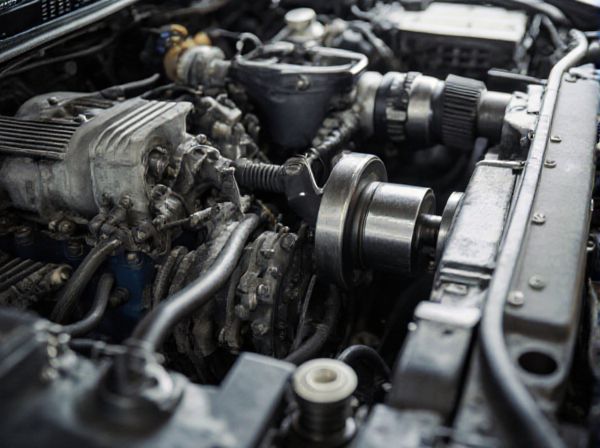
Photo illustration: Balance Shaft vs Harmonic Damper
A balance shaft reduces engine vibrations by counteracting imbalances created during the combustion process, improving overall smoothness and engine longevity. The harmonic damper, also known as a vibration damper or crankshaft damper, protects the crankshaft from torsional vibrations that can cause damage or fatigue over time. Understanding the difference between these components helps you maintain your engine's performance and reliability effectively.
Table of Comparison
| Feature | Balance Shaft | Harmonic Damper |
|---|---|---|
| Purpose | Reduces engine vibrations by counteracting secondary imbalances | Controls torsional vibrations in the crankshaft |
| Location | Inside engine block, near crankshaft | Attached to front of crankshaft |
| Type of Vibration Addressed | Rotational and secondary engine imbalance vibrations | Torsional crankshaft vibrations |
| Components | Counter-rotating shafts with weights | Rubber or viscous damping element with a mass hub |
| Common Uses | Inline-4 and other engines prone to imbalance | Almost all internal combustion engines |
| Impact on Engine | Improves smoothness and reduces noise | Prevents crankshaft damage and reduces vibration noise |
| Maintenance | Low; shafts require little service | May require periodic inspection/replacement of damping element |
| Cost | Higher manufacturing complexity and cost | Relatively low cost and easy to replace |
Introduction to Engine Vibration Management
Balance shafts reduce engine vibration by counteracting imbalances in the rotating assembly, typically in inline-four or three-cylinder engines to smooth out secondary vibrations. Harmonic dampers, also known as vibration dampers, are attached to the crankshaft to absorb torsional vibrations caused by the firing pulses and prevent damage from harmonic resonance. Both components are essential in engine vibration management, enhancing engine smoothness, durability, and overall performance.
What is a Balance Shaft?
A balance shaft is an engine component designed to reduce vibrations by counteracting the secondary forces generated by the pistons and crankshaft during engine operation. It consists of weighted shafts that rotate in opposite directions to the crankshaft, effectively neutralizing engine imbalance and improving overall smoothness. Unlike a harmonic damper, which primarily absorbs torsional vibrations, a balance shaft directly corrects mechanical imbalances for enhanced engine refinement.
Understanding the Harmonic Damper
The harmonic damper, also known as a harmonic balancer, is a critical engine component designed to reduce torsional vibrations in the crankshaft, which helps prevent potential engine damage over time. Unlike the balance shaft that counteracts engine imbalance by creating opposing forces, the harmonic damper uses a rubber or elastomer ring between its mass and hub to absorb and dissipate vibrations caused by the crankshaft's rotational forces. Proper understanding and maintenance of the harmonic damper are essential to ensure smooth engine performance and longevity, especially in high-performance or turbocharged engines.
How Balance Shafts Work
Balance shafts reduce engine vibrations by counteracting the unbalanced forces generated by the pistons and crankshaft movement, using counter-rotating weighted shafts timed precisely to engine rotation. Positioned within the engine block, these shafts rotate at twice the crankshaft speed to neutralize secondary vibrations in inline four-cylinder engines. Unlike harmonic dampers that absorb and dissipate torsional vibrations at the crankshaft front, balance shafts actively cancel out engine shake, leading to smoother operation and enhanced driver comfort.
How Harmonic Dampers Function
Harmonic dampers function by reducing torsional vibrations in the crankshaft through a mass tuned to counteract specific vibration frequencies, thereby protecting engine components from stress and failure. Unlike balance shafts that mechanically offset engine imbalances by rotating counterweights, harmonic dampers utilize a rubber or elastomeric damper system to absorb and dissipate vibrational energy. This targeted vibration control enhances engine smoothness and longevity, particularly in high-revving or high-performance engines.
Key Differences: Balance Shaft vs Harmonic Damper
Balance shafts reduce engine vibrations by counteracting imbalances in the crankshaft's motion, improving smoothness in inline-four and V6 engines. Harmonic dampers primarily control torsional vibrations in the crankshaft, protecting the engine from stress and potential damage. Key differences lie in their function: balance shafts focus on vibration reduction through added rotating weights, while harmonic dampers absorb and dissipate torsional energy to maintain crankshaft integrity.
Applications in Modern Engines
Balance shafts reduce engine vibration in inline-four and three-cylinder engines by counteracting secondary imbalances, enhancing smoothness and comfort in compact cars and motorcycles. Harmonic dampers, attached to the crankshaft, minimize torsional vibrations to protect timing components and improve engine longevity, commonly found in inline-six and V8 engines. Modern engines often integrate both systems to optimize NVH (Noise, Vibration, and Harshness) characteristics and maintain performance under varying loads.
Pros and Cons of Balance Shafts
Balance shafts significantly reduce engine vibration by counteracting imbalances in inline-four and other engine configurations, improving overall smoothness and driving comfort. However, they increase engine complexity, add weight, and may slightly reduce fuel efficiency due to additional mechanical friction. Unlike harmonic dampers that primarily mitigate crankshaft torsional vibrations, balance shafts address primary and secondary engine vibrations but require precise calibration and maintenance to avoid potential reliability issues.
Pros and Cons of Harmonic Dampers
Harmonic dampers effectively reduce torsional vibrations in crankshafts, enhancing engine longevity and smooth operation. They prevent crankshaft failure by absorbing and dissipating vibrational energy, but can wear out over time, requiring maintenance or replacement. Compared to balance shafts, harmonic dampers offer a simpler solution with fewer moving parts but are less effective in counteracting primary engine imbalances.
Choosing the Right Solution for Your Engine
Balance shafts reduce engine vibrations by counteracting secondary imbalances, enhancing smoothness in inline four-cylinder and V6 engines. Harmonic dampers absorb and dissipate torsional vibrations in the crankshaft, protecting engine components from stress-induced damage. Selecting the right solution depends on engine type, vibration frequency, and performance requirements, with balance shafts ideal for reducing primary engine vibrations and harmonic dampers crucial for extending crankshaft longevity.
 caratoz.com
caratoz.com